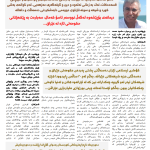A NEW UNDERSTANDING OF THE RELATIONSHIP BETWEEN COMMUNIST PARTY AND WORKERS’ STRUGGLE
Chapter 3 of New Communism Book
We said in the previous chapter that the working class and the class struggle make history, not communism. Communists are part of the intellectuals, as Gramsci puts it: “it itself reflects the growth and expansion of the foundation and structure of the working class”[1] which emerges and grows as the intellectual part of the organ of this class. And there we criticized the metaphysical view that considers the history of communism as the history of individuals, parties, organizations, and political currents, and contrary to the dialectical reality of the growth of the working class and its class struggle, which is the basis for the emergence, success, and failures of communism in the capitalism society.
This perception is clearly seen in the issue of the party. Therefore, we will make a comprehensive analysis of the current view of this concept and its history and the changes that have taken place to present the real position of the party in the communist worldview.
The party has become merely an abstract statement and a phenomenon detached from class communism and the working class, which has itself changed from an instrument to become a goal and a sanctification. Contemporary communism has become fetishized, and resembles Hagel’s dialectical dissection, which ended history with the attainment of the state and bourgeois rights.
Therefore, we must first, to pull out the concept of the party from the world of abstract politics and return it to its historical form, so that we can see the real role of this political tool as a real concept in the world of class warfare, far from idolatry.
In the capitalist system, the ruling class in a historical process develops its method of organization in the form of a separate political party, which is the result of separate layers of capital and the formation of distinct intellectual and political forms in relation to the internal problems of the capitalist system.
In a large part of the world today, where parliamentarism has taken the form of the political administration of bourgeois rule, this class has gathered around different political, economic, and social program, but according to the same basis for maintaining the capitalist system, and has separate and opposing parties. They are competing for control of the government and the state. This is part of the process of state-building, which the bourgeoisie undertook to centralize markets and regions, to build large cities and executive apparatuses, and to suppress and respond to the needs of capital development, and thus to take a place of a serfdom system based on Villages and scattered federal governments were established.
The concept and phenomenon of the party in the eyes of the working class has also developed along with the growth of statistics and the economical position of this class in the of capitalism and as a result of the revolutionary experience of the working class as well. The “spontaneous” movement and the imaginary goals of this class first appear in Europe. Communism emerges as a historical element of the class struggle from the Jacobins of the French Revolution to the English Chartres and the mid-nineteenth-century revolutions in Europe, not as a theory put forward by reformists such as Robert Owen, Proudhon, and Marx. Among these spontaneous elements of the working class there is always a class awakening, which expresses class interests. Communism has grown and developed in the heart of these spontaneous processes and has enlightened the class awakening and has drawn a scientific approach to the imaginary demands of this class. The party and the organization of the workers were among the effects of this process of awakening, in which this class manifested itself as a class in separate stages and in separate ways. Thus, the party is a form made by the class, not the party makes the class and the class struggle. The party is a stage of organized struggle that represents the awakening of a class, not an awakening that builds a class and a class struggle. When the collective demand of the workers reached the level of a revolution against bourgeois and the capitalist system, then communism became a revolutionary theory that expressed the necessity and manner of this change. The Manifesto and the First International reflect the fact that there is a class in the political arena that has taken a definite form. As Gramsci puts it: “History has presented this organism. It is the political party, the first element of which is the common desire to globalize and generalize.”[2]
Here we must dwell on one point, which is the party’s dependence on the class struggle. If the party is the result of the growth of the workers’ struggles, then the laws that govern the development and survival of the party are the laws of class struggle. This equation tells us that the party is part of a social process, which is influenced by the power that drives this process. If this power is small, scattered, unplanned and inexperienced in the beginning, the party will be the same. But if the organic parts of the party are the three constituent parts; First, a disciplined and organized working-class population; Second: Political intellectuals who have the ability to unite this force. And third, if the tools that bind the two upper parts together exist, then the stage of transferring the class struggle to the highest level, that is, taking action to gain power, begins.
This growth and development begin with a historical process in which the material and social contexts of the working-class struggle against capitalism have been assessed. For example, two decades of class struggle and the French class war from the Revolution of 1848 to 1870 led to the Paris Commune. Here arises the communist awakening, not in the specific partisan sense, but in the sense of a work of the working class that the aim of the workers’ political and class struggle is to gain power. For the first time, the workers are raising their political power to the level of hegemony over society, and from here the character of the commune government and workers’ government became the future form and character of the workers’ party. Hence the communist theory or worldview, especially for Marx and Engels, about the communist state and society became clearer.
Although in the Manifesto the party meant an organized working class, which must organize itself like an authority, after the examination of the commune the party is denoted a continuous class of revolutionaries, who not only replace the bourgeois party with a seat of the authority. But it destroys all the apparatuses of the bourgeois state and the state itself. This definition changes and expands the party, transforming the horizon and perspective of the class struggle from an economic struggle demanding democracy and economic reforms to an organized political struggle that seeks to revolutionize the entire capitalist system. Hence Marx’s theory becomes a more complete statement of communism than the socialist theories of Proudhon, Blanqui, Lassalle, and others. But it is not Marx’s theory that determines the future of the class struggle and presents the class awakening in a partisan form, but rather the political and intellectual rivalry that takes place at the working-class level and in the arenas of daily and all-out struggle will decide on where are plans, tactics, and perceptions and tools of struggle and future going to?
Marx and Engels’ insistence that the party is not just a distinct group and a party called the Communist Party but the whole political and organized working class is a party, this is quite different from Lenin’s view of a party that includes only the Communists. And insists on political program and tactics as the dividing point between the workers’ movement and the communists. This is the result of a history of class struggle at the Western and Russian levels, as we will see below.
After the commune we are witnessing great changes in the class struggle, the emergence of the Second International and the expansion of labour parties in Europe and Russia and the United States are among the effects of these changes. At this stage, two issues dominate the way communism is perceived and programmed.
First, for the Labour Party to be able to muster a popular power in the political arena and to fight for the rights of the working class, it must act openly and seek power within the framework of parliamentary democracy.
The second issue, which is more influenced by the revolutionary situation in Russia, and which affects the whole of Europe with the outbreak of World War I, is that the Labour Party, by seizing political power through the revolution, must learn from the Paris Commune and disarm the bourgeoisie and make up its government’s party. From this Russian experience, the criterion of the Labour and Communist Party is determined based on its readiness for revolution, and the party is placed as the representative of the working class, defending that the party power should replaces the power of the working class.
In carrying out this process, two types of political parties emerge. The Social Democratic Party, which with the trade union created the method of popular and professional organization, the reform program, and the parliamentary list, and became part of the political system of Western European governments. The Russian Bolshevik Party, under the conditions of Russian repression, will have various methods of organizing the secret professional party, the masses Union and the parliamentary list, and has a revolutionary program and demand, which is itself influenced by the Russian revolutionary conditions, and wants a Caesarean political system to be changed and socialism as a substitute for capitalism to be carrying out. This model, however, a bureaucratic party and a one-party power emerge and banned different factions and political parties.
In contrast to the Social Democratic form of party and popular organization, which takes on a reformist, bureaucratic content, a revolutionary critique of direct popular democracy emerges, in which Rosa Luxemburg and many other leaders also play an important role. Ernest Mandel’s book “On Bureaucracy”[3] gives a clear idea of the history of bureaucracy that we use in this study.
At the same time, there was a critical current in World War I against the nationalist policies of the main parties of the Second International, of which Lenin was one of the leaders. This tactical issue became one of the problems and internal rivalries of the communist movement.
Also, because of the victory of the anti- Caesarean revolution in Russia, the class struggle spread rapidly and affected that time’s issues of political struggle and anti-capitalist revolution. This class struggle also brings about changes in the Russian Social Democratic parties.
Once again, after the commune, the communist movement is being tested to find its hegemony over society, and it must show its power as an alternative to the political power of the bourgeoisie. This creates a kind of separation from the common contemporary social democratic method, which seeks change through parliamentary struggle and staying within the framework of the capitalist system.
The Bolshevik Party becomes the character of the state, and the collective and general socialist desire of the working class is formed around the Bolshevik alternative to power. But inside the Bolshevik Party is criticized by the Workers’ Opposition faction, and among them Kollontai, and outside the party by Rosa Luxemburg, Lenin’s position and policies are criticized by the party and the government as the bureaucratic party method and one-party power and banning the faction and it takes on a distinct political party. In the character of the Soviet state, we must look for Lenin’s view of the party and the role of the party in communist society.
Although in the Marx era the working class is still at the beginning of its experience, and the Communist Manifesto says in a rudimentary way that workers must be organized as a ruling class that carries out a series of reforms. This is the lesson of the Paris Commune experience which shows how dark and vague is this system and the communist world of the workers, and how another tool and step is needed to create a communist society?
Lenin worked on the workers’ state according to Marx’s advice on the Paris Commune. In the eyes and structure of the party as the character of the state, these steps show progress, but now, after a century, we see how imperfect and vague the aims and steps of the workers’ and communists’ parties are, as well as the actions of the Bolsheviks and the soviet government is different with the necessities of political and economy liberation of the working class from the capitalist system!
The question that arises is why did the critique and separation of Bolshevism from the social-democratic current of the reformists within the labour movement went towards the model of a bureaucratic party and state? What effect did this model have on the whole form of the party in the twentieth century, and how did the emergence of the party based on the same program and pro-government replace the concept of uniting the working class in the party? What role did this process play in the separation of the communist intellectuals and the communist movement from the workers? How has the notion of the class struggle and the working-class party become the representative party of the working class and the elite that makes history for the working class instead of the working class? To answer these and many other questions, one must research this party model.
The Paris Commune was defeated by the enemies of the working class, but the October Revolution was defeated by the Workers’ and Communist Party. All these defeats tell us that the class struggle of the workers at this time was faced with problems and issues that this class was not yet intellectually, politically, and organizationally prepared to overcome. Instead of glorifying this past, this forces us to scientifically analyses its shortcomings and look for the reasons for the failure of his revolutions in the heart of this class struggle and its tools.
However, the issue of party and government are two sides of the same phenomenon, or they are a phenomenon on two different levels. But to analyse the phenomenon of communism, we must discuss these two organs of this body separately. In this article, we emphasize the issue of the party and the party model, what effect the party has on the success and failure of the revolution, and more importantly, what model of political, social, and economic system it shows, and how a free and collective human world will be reflected in politics and party’s practice? After this analysis and interpretation of the relationship between the party and the class struggle and the process and history of partisanship in communism, in the next chapter we will consider the party itself as a part of the class organ and how the party concept is related to the class, government, program and politics.
[1] Gramsci, Prison Notebooks, Problems of History and Culture, P5
[2] Gramsci, Prison Notebooks, The Modern Prince, P129








Add Comment